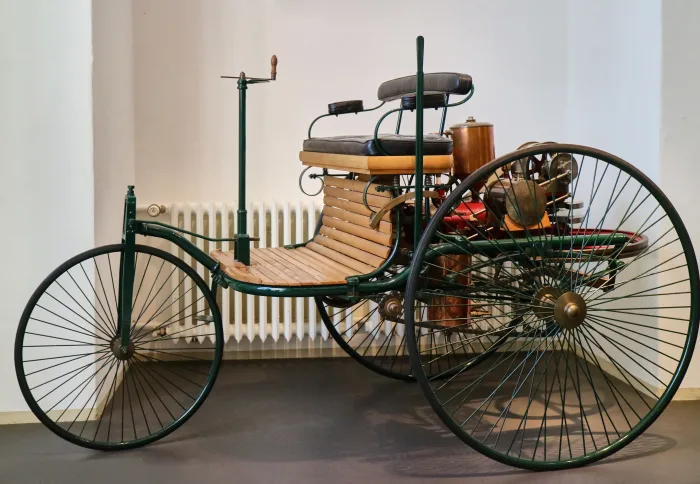Happy February, everybody! I had a blast at MTE in Orlando, but I’m back in the frozen tundra and looking forward to making it through the rest of the winter. Just one more month, and we can start hoping for spring.
Today we’re going to talk about the history of the car industry. Not only do I appreciate that the auto industry provides me with a way to make a living, but I am also grateful for the people I’ve met and the terrific experiences I’ve encountered because of my business. Take a look at the timeline below. You might find a few surprises.
Timeline of the auto industry:
June of 1886- German mechanic Carl Bentz introduced a patent for the first automobile

1900- Porsche introduces the first hybrid car in Paris. Yes, that’s right, the hybrid car is nothing new. If you factor in inflation, the early 1900 hybrid vehicles would run you between $91,000 and $216,000. It kind of makes that new Tesla sound more affordable.
November of 1903- Mary Anderson invented the first windshield wiper. Mary’s invention didn’t win her fame or fortune due to her gender. Cadillac picked up the idea of the windshield wiper in 1922, and soon they were in just about every automobile.
December of 1906- A new company by the name of Rolls-Royce introduces the Silver Ghost.
1912- Cadillac introduces technology that makes the crank engine obsolete.
December of 1913- Henry Ford starts rolling out his Model Ts on the assembly line. This move by Ford creates a boon to the economy and a car that middle-class Americans can afford.
1915- CR Anderson opens the first African Car company in Greenfield, Ohio. Anderson, who was born in 1833, was a formerly enslaved person. The initial company only lasted a couple of years, but he manufactured body parts for buses and large vehicles until the Depression.
1934- Chrysler introduces the Airflow Streamline design.
May of 1938- Adolph Hitler introduced the Beetle Volkswagen and called it a car for the masses. Apparently, Henry Ford inspired him to do so. Too bad he didn’t pattern more of his life after Ford’s.
November of 1940- Willys Overland introduces the first Jeep for the U.S. Army.
May of 1947- The first red Ferrari appeared.
August of 1959- Volvo began offering seatbelts in their vehicles, but they didn’t become mandated until 1968.
August of 1959- Greek designer Sir Alec Issigonis starts the mini-revolution with the Morris Mini-Minor and the Austin 7. The fuel-efficient vehicles were meant to save money and energy but became a vehicular fashion statement when the Beatles started driving them.
September of 1963- The Porsche 911 model makes its debut in Frankfurt, Germany. It becomes an instant classic.

April of 1964- The Ford Mustang arrives on the scene Sales soar off the charts right away, but then they really get crazy after Steve McQueen drives one in the film ‘Bullitt.'
November of 1965- Ralph Nader publishes ‘Unsafe at any Speed.’ Nader’s consumer report sparks safety awareness, and President Johnson calls for regulatory agencies.
1968- The first airbag becomes available.
December of 1970- The Clean Air Act and the EPA takes a stand on pollution caused by automobiles by introducing regulations and catalytic converters.
July of 1971- The Land Rover lands on the moon.

October of 1997- Toyota comes out with the Prius Hybrid.
December of 2008- A robotic car delivers pizza in the San Francisco area. If you think a robotic car will deliver your next pizza, think again. The bay area had a police escort, and we don’t know whether the pizza was still hot when it arrived.
June of 2012- Tesla comes out with a car run totally on electricity.
Henry Ford and the Minnesota connection:

Those living or working in the Twin Cities area most likely know of the Highland Park Ford plant that closed its doors in 2011. But that isn’t where the Henry Ford and Minnesota connection begins.
Henry Ford began selling the ‘Ford mobile’ at Tenvoorde’s Bicycle Shop in St. Cloud, Minnesota, in 1903. Today, the Tenvoorde family still owns and operates the world’s oldest Ford dealership.
Ford branched out to Minneapolis in 1912 and then made his way across the river in 1925. Ford was a ‘green industrialist’ before we even knew there was such a thing. His attraction to St. Paul stemmed from the city’s abundance of available raw materials. St. Paul provided a ton of pure silica, for example, a material used to form glass.
So, we’ve provided just a few highlights of the auto industry. We’ll talk more about the future of cars at a later date. But you know what they say, ‘live in the present.’ And if your vehicle doesn’t look its best because of dents and dings, you know who to call. Gray Duck Dent Repair will come to you. Contact us here for an appointment or an estimate.
Stay Warm Everybody!



Comments